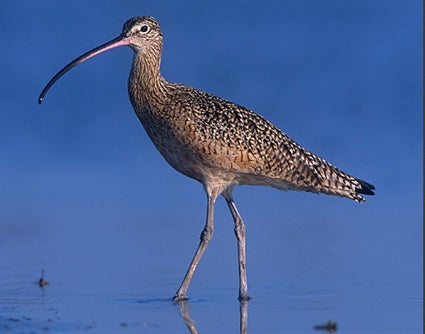SCIENTIFIC NAME:
Numenius americanus
STATUS:
Occasional to rare in winter, spring, fall, and late summer in Gulf Coast region.
DESCRIPTION:
Long-billed curlews are 20 to 26 inches tall and are North America’s largest shorebird. They have a wingspan of 10 to 12 inches and weigh 18 to 34 ounces. It gets its name from an extremely long, down-curved bill. They are a buffy-brown color with no prominent barring or striping. The underside of each wing is bright cinnamon colored and visible in flight.
The bill of the female long-billed curlew is longer than that of the male and of a different shape. The female’s bill is flatter on top with a more pronounced curve at the tip. The bill of a male is gently curved throughout its length.
The call is a distinctive whistled “cur-lee” that rises on the second note. Observers have also noted a rapid whistled “kli-li-li-li.’
The whimbrel, a similar species, is slightly shorter and has distinct stripes on top of the head. The whimbrel also has a shorter bill and lacks the cinnamon coloration on the underside of its wings. It is also less uniform in color and has more prominent barring than the long-billed curlew.
DISTRIBUTION:
Long-billed curlews are one of the most threatened shorebird species on the North American continent. The summer range of the long-billed curlew includes much of the western United States along with the southern portion of the Canadian prairie provinces. It winters primarily from central California and coastal Texas southward through Mexico. They are also found wintering on the southern Atlantic Coast and both coastlines of Florida. Small numbers are observed each year during the winter months on Alabama’s Gulf Coast. Nationally, habitat degradation and small population numbers make this a species of very high conservation priority.
HABITAT:
They are found in the native grasslands of arid western North America and also in farm fields and grasslands during migration. Wintering habitat includes coastal marshes and mudflats.
FEEDING HABITS:
Feeds primarily on grasshoppers, crickets, beetles, caterpillars and other insects while on its breeding grounds. Food items on their wintering grounds include large marine invertebrates. Its bill is best adapted for capturing shrimp and crabs living in deep burrows on tidal mudflats. They are also capable of probing for food items, including earthworms, slightly under the surface of the soil or mud.
LIFE HISTORY AND ECOLOGY:
Male long-billed curlews use an impressive aerial display to attract a female mate. Nests are constructed on the ground usually in open, dry prairie habitat. Clutch size averages four eggs that are incubated by both parents for 27 to 30 days. Both parents will aggressively defend the nest site.
Chicks are downy at birth and leave the nest shortly after hatching. Hatchlings receive parental care from both adults, but are capable of feeding themselves. Females typically abandon the brood several weeks after hatching and leaves brood care to the mate. Despite this abandonment of the brood, the male and female often form a pair bond the following year.
REFERENCES:
http://www.wikipedia.org/wiki/Long-billed_curlew
Imhof, Thomas A. 1962. Alabama Birds. State of Alabama, Department of Conservation and Natural Resources, Game and Fish Division by the University of Alabama Press
Robbins, Chandler S, Bertel Bruun, and Herbert S. Zim. 1983. A Guide to Field Identification Birds of North America. Western Publishing Company.
AUTHOR:
Ray Metzler, Wildlife Biologist, Alabama Division of Wildlife and Freshwater Fisheries






